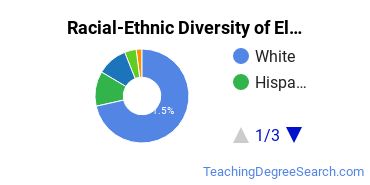Elementary Education at Kennesaw State University
KSU Georgia is located in Kennesaw, Georgia and has a total student population of 41,181.
Want to know more about the career opportunities in this field? Check out the Careers in Elementary Education section at the bottom of this page.
KSU Georgia Elementary Education Degrees Available
- Bachelor’s Degree in Elementary Teaching
- Master’s Degree in Elementary Teaching
Online Classes Are Available at KSU Georgia
If you are a working student or have a busy schedule, you may want to consider taking online classes. While these classes used to be mostly populated by returning adults, more and more traditional students are turning to this option.
Are you one of the many who prefer to take online classes? KSU Georgia offers distance education options for elementary teaching at the following degree levels:
- Master’s Degree
KSU Georgia Elementary Education Rankings
The elementary teaching major at KSU Georgia is not ranked on College Factual’s Best Colleges and Universities for Elementary Education. This could be for a number of reasons, such as not having enough data on the major or school to make an accurate assessment of its quality.
There were 0 student who received their doctoral degrees in elementary teaching, making the school the #8 most popular school in the United States for this category of students.
Elementary Teaching Student Demographics at KSU Georgia
Take a look at the following statistics related to the make-up of the elementary teaching majors at Kennesaw State University.
KSU Georgia Elementary Education Bachelor’s Program

About 67% of those who receive a bachelor's degree in elementary teaching at KSU Georgia are white. This is typical for this degree on the nationwide level. Prospective students may be interested in knowing that this school graduates 6% more racial-ethnic minorities in its elementary teaching bachelor's program than the national average.*
The following table and chart show the race/ethnicity for students who recently graduated from Kennesaw State University with a bachelor's in elementary teaching.

| Race/Ethnicity | Number of Students |
|---|---|
| Asian | 6 |
| Black or African American | 7 |
| Hispanic or Latino | 26 |
| White | 95 |
| International Students | 1 |
| Other Races/Ethnicities | 6 |
KSU Georgia Elementary Education Master’s Program

Of the students who received a elementary teaching master's degree from KSU Georgia, 65% were white. This is below average for this degree on the natiowide level. In the elementary teaching master's program at this school, racial-ethnic minorities make up 29% of degree recipients. That is 4% better than the national average.*
The following table and chart show the race/ethnicity for students who recently graduated from Kennesaw State University with a master's in elementary teaching.

| Race/Ethnicity | Number of Students |
|---|---|
| Asian | 3 |
| Black or African American | 16 |
| Hispanic or Latino | 2 |
| White | 47 |
| International Students | 0 |
| Other Races/Ethnicities | 4 |
Related Majors
- Early Childhood Education
- Teacher Education
- Junior High/Intermediate/Middle School Education & Teaching
- Secondary Education
Careers That Elementary Teaching Grads May Go Into
A degree in elementary teaching can lead to the following careers. Since job numbers and average salaries can vary by geographic location, we have only included the numbers for GA, the home state for Kennesaw State University.
| Occupation | Jobs in GA | Average Salary in GA |
|---|---|---|
| Elementary School Teachers | 53,940 | $56,360 |
References
*The racial-ethnic minorities count is calculated by taking the total number of students and subtracting white students, international students, and students whose race/ethnicity was unknown. This number is then divided by the total number of students at the school to obtain the racial-ethnic minorities percentage.
More about our data sources and methodologies.
